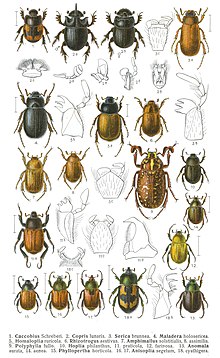Scarabaeidae
| Scarab beetle | |
|---|---|

| |
| Central European scarab beetles with some anatomical details. Edmund Reitter's Fauna Germanica, 1908 | |
| Scientific classification | |
| Domain: | Eukaryota |
| Kingdom: | Animalia |
| Phylum: | Arthropoda |
| Class: | Insecta |
| Order: | Coleoptera |
| Suborder: | Polyphaga |
| Infraorder: | Scarabaeiformia |
| Superfamily: | Scarabaeoidea |
| Family: | Scarabaeidae Latreille, 1802 |
| Subfamilies[1][2][3] | |
| |

The family Scarabaeidae, as currently defined, consists of over 35,000 species of beetles worldwide; they are often called scarabs or scarab beetles. The classification of this family has undergone significant change. Several groups formerly treated as subfamilies have been elevated to family rank (e.g., Bolboceratidae, Geotrupidae, Glaresidae, Glaphyridae, Hybosoridae, Ochodaeidae, and Pleocomidae), and some reduced to lower ranks. The subfamilies listed in this article are in accordance with those in Catalog of Life (2023).[3]
Description
[edit]
Scarabs are stout-bodied beetles, many with bright metallic colours, measuring between 1.5 and 160 millimetres (0.059 and 6.3 in). They have distinctive, clubbed antennae composed of plates called lamellae that can be compressed into a ball or fanned out like leaves to sense odours. Many species are fossorial, with legs adapted for digging. In some groups males (and sometimes females) have prominent horns on the head and/or pronotum to fight over mates or resources.[4] The largest fossil scarabaeid was Oryctoantiquus borealis with a length of 50 millimetres (2.0 in).[5]

The C-shaped larvae, called grubs, are pale yellow or white. Most adult beetles are nocturnal, although the flower chafers (Cetoniinae) and many leaf chafers (Rutelinae) are active during the day. The grubs mostly live underground or under debris, so are not exposed to sunlight. Many scarabs are scavengers that recycle dung, carrion, or decaying plant material.[6] Others, such as the Japanese beetle, are plant-eaters, wreaking havoc on various crops and vegetation.
Some of the well-known beetles from the Scarabaeidae are Japanese beetles, dung beetles, June beetles, rose chafers (Australian, European, and North American), rhinoceros beetles, Hercules beetles and Goliath beetles.
Several members of this family have structurally coloured shells which act as left-handed circular polarisers; this was the first-discovered example of circular polarization in nature.[7]
Ancient Egypt
[edit]In Ancient Egypt, the dung beetle now known as Scarabaeus sacer (formerly Ateuchus sacer) was revered as sacred. Egyptian amulets representing the sacred scarab beetles were traded throughout the Mediterranean world.[4]
See also
[edit]- Dung beetle – Scarabaeidae dung beetles play an important role in temperate and tropical environments
- List of Scarabaeidae genera
- List of Scarabaeidae subfamilies and tribes
- Scarab artifact
References
[edit]- ^ Bouchard, Patrice; Bousquet, Yves; Davies, Anthony E.; Alonso-Zarazaga, Miguel A.; et al. (2011). "Family-group names in Coleoptera (Insecta)". ZooKeys (88): 1–972. Bibcode:2011ZooK...88....1B. doi:10.3897/zookeys.88.807. ISSN 1313-2989. PMC 3088472. PMID 21594053.
- ^ Dietz, Lars; Seidel, Matthias; Eberle, Jonas; Misof, Bernhard; et al. (2023). "A transcriptome-based phylogeny of Scarabaeoidea confirms the sister group relationship of dung beetles and phytophagous pleurostict scarabs (Coleoptera)". Systematic Entomology. 48 (4): 672–686. Bibcode:2023SysEn..48..672D. doi:10.1111/syen.12602.
- ^ a b "Scarabaeidae Latreille, 1802". Catalogue of Life. Retrieved 2023-09-22.
- ^ a b bugguide.net Family Scarabaeidae - Scarab Beetles
- ^ Brett Ratcliffe, Dena M. Smith, Diane Marie Erwin. "Oryctoantiquus borealis, New Genus and Species from the Eocene of Oregon, U.S.A., the World's Oldest Fossil Dynastine and Largest Fossil Scarabaeid (Coleoptera: Scarabaeidae: Dynastinae)". 2009. The Coleopterists Bulletin 59(Mar 2005):127-135 DOI:10.1649/0010-065X(2005)059[0127:OBNGAS]2.0.CO;2
- ^ Marcos Paulo Gomes Gonçalves (2017). "Relação Entre Tempo e Besouros em Mata de Cocal" [Relationship Between Meteorological Conditions and Beetles in Mata de Cocal]. Revista Brasileira de Meteorologia (in Portuguese). 32 (4): 543–554. doi:10.1590/0102-7786324003.
- ^ A. A. Michelson (1911). "On metallic colourings in birds and insects". Philosophical Magazine. 21 (124): 554–567. doi:10.1080/14786440408637061.
Further reading
[edit]- RU Ehlers. Current and Future Use of Nematodes in Biocontrol: Practice and Commercial Aspects with Regard to Regulatory Policy Issues. Biocontrol Science and Technology Volume 6, Issue 3, 1996.
External links
[edit]- Flickr Images on Flickr
- Scarabaeidae breeding site Photos of various Cetonidae, Dynastidae, Euchiridae, Lucanidae and Trichinae]
- Family SCARABAEIDAE
- June Beetles, Family: Scarabaeidae - Diagnostic photographs
- Bibliography of literature published on scarab beetles since 1 January 2001 (worldwide coverage; through 2005)
 Data related to Scarabaeidae at Wikispecies
Data related to Scarabaeidae at Wikispecies Media related to Scarabaeidae at Wikimedia Commons
Media related to Scarabaeidae at Wikimedia Commons
